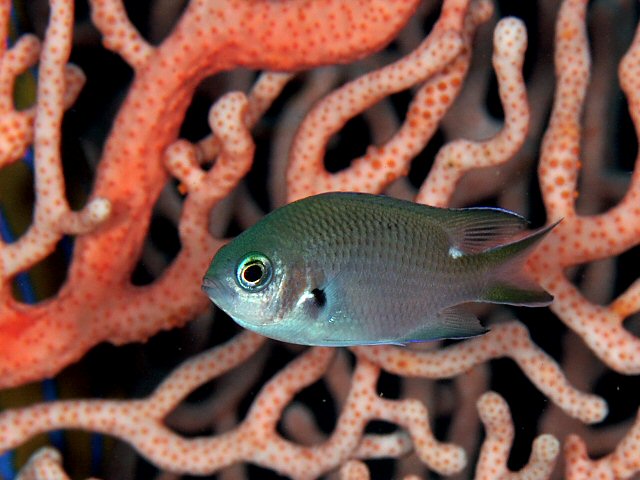
“Dither fish” are, simply put, the “advance guard” or the early warning bells to the other fish. They are usually small, schooling fish, the ones that are usually the first to react to a potential threat. The theory is simple and is seen throughout nature, be it in the ocean, rivers, even on land in forests or on the prairie. A single, larger animal without the benefit of a school has only its own senses to rely on. A deer in the forest, for example, has only its own two eyes and two ears to rely on to sense a predator or potential threat. But, in the forest, birds are singing, squirrels and other animals are scurrying about. If the birds suddenly go quiet or fly off, this can tip off to the deer that something may be wrong since there are often far more birds communicating with each other than there are deer in a group.
 In the water – ocean, river or lake – “dither fish” serve the same purpose. If a school of a hundred Green Chromis on the reef suddenly disappear into the coral, a lone grazing angelfish may be tipped off that something is wrong or that a predator may be lurking. In the aquarium, that same angelfish finds it is suddenly on its own. It may hide to protect itself since those visual alarms are no longer around. Adding dither fish can encourage a timid new addition to come out and play. Examples of some fish commonly used for this purpose are danios, tetras and small cichlids in freshwater, or chromis, cardinalfish and dartfish in saltwater aquariums.
In the water – ocean, river or lake – “dither fish” serve the same purpose. If a school of a hundred Green Chromis on the reef suddenly disappear into the coral, a lone grazing angelfish may be tipped off that something is wrong or that a predator may be lurking. In the aquarium, that same angelfish finds it is suddenly on its own. It may hide to protect itself since those visual alarms are no longer around. Adding dither fish can encourage a timid new addition to come out and play. Examples of some fish commonly used for this purpose are danios, tetras and small cichlids in freshwater, or chromis, cardinalfish and dartfish in saltwater aquariums.
Replicating the environment a fish comes from comes down to more than just giving it the right pH and temperature and décor. It can also be important to give it the proper level of activity that its used to. Sure, some fish like a placid solitary environment and for others, adding a school of small fish is going to encourage more snacking than swimming, but sometimes a newcomer just needs a few extra eyes and ears to help it venture out into the open.
If this sounds like your tank and you need to figure out if dither fish (and what kind) would be right for you, let us know!
Thanks,
Eileen
Giant Danio image referenced from wikipedia and originally posted by Faucon
 That Fish Blog – Aquarium Advice and Information
That Fish Blog – Aquarium Advice and Information

I am looking into dither fish and was wondering what would go best as a salltwater fish with Bicolor Blenny, a Firefish, a Yellow Assessor, and a Red Head Goby? Thank you
Hello Madison, What size is your aquarium? Some examples that we mentioned above were chromis, cardinalfish and dartfish in saltwater aquariums but the appropriate fish for your tank would also depend on the tank size.